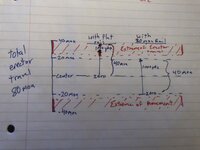Rwolf
FNG
- Joined
- Jul 28, 2020
- Messages
- 62
I am rigging out a 300 win mag with a Zeiss V4 4-16x44. I do not see myself shooting out over 600-700 yds. Do I need a 20 moa rail?
You beat me to the optically centered clarity aspect.FWIW, my understanding is that the elevated rail serves two purposes. One to give enough elevation travel—but I cant think of more than tiny handful of dialable scopes that dont have enough elevation travel to reach 1000 yards, which even on my old school short action cartridge is less than 10 mils. The other reason is to keep the reticle travel nearer to the center of the adjustment range. I have been told this affects both optical quality as well as consistency of the erector movement. Perhaps someone with more scope knowledge than I have could weigh in on that.
But doesn't that mean that your zero is located farther from the optical center? At what shooting distance is it best to have the crosshairs near the center- at the distance you shoot most, or at the farther distance where error is magnified.FWIW, my understanding is that the elevated rail serves two purposes. One to give enough elevation travel—but I cant think of more than tiny handful of dialable scopes that dont have enough elevation travel to reach 1000 yards, which even on my old school short action cartridge is less than 10 mils. The other reason is to keep the reticle travel nearer to the center of the adjustment range. I have been told this affects both optical quality as well as consistency of the erector movement. Perhaps someone with more scope knowledge than I have could weigh in on that.
EVERYTHING below your zero is totally worthless. Please tell us how a 20moa rail will complicate this. It'll be funnier than heck......@Rwolf These scopes have 80 MOA of elevation travel 40 up & 40 down at factory zero stop, Why complicate the equation with a 20 MOA rail.
So you making fun of arithmetic challenged and disadvantaged persons?EVERYTHING below your zero is totally worthless. Please tell us how a 20moa rail will complicate this. It'll be funnier than heck......
60 up, 20 down. Better division.So you making fun of arithmetic challenged and disadvantaged persons?Like I said, just my 2 cents.
I only got 10 fingers & 10 toes fer countin’60 up, 20 down. Better division.
Does this explain it better? a 20moa rail puts both your zero and any dialed solution out past 1000 yards with most centerfire rifles into the middle-half of the erector movement, where it is less susceptible to binding the windage movement, optical distortion, and the movement would be more consistent. With a flat rail you only actually get 40moa of useable travel, and at some point inside a distance many people shoot you will wind up using the extrene end of the erector movement, which has issues associated with it. in this case with a 20moa rail you actual get a theoretical 60moa of travel, and you dont wind up using that "red zone" until you are well past most rifles 1000yard solution. That's the story I've gotten anyway.I only got 10 fingers & 10 toes fer countin’

I was prepared to scribble something like this when waiting on my truck oil change, but my Dad walked in and that venture was over, LOL.Does this explain it better? a 20moa rail puts both your zero and any dialed solution out past 1000 yards with most centerfire rifles into the middle-half of the erector movement, where it is less susceptible to binding the windage movement, optical distortion, and the movement would be more consistent. That's the story I've gotten anyway.View attachment 504321
I'd imagine that red zone would be contingent upon quality of the scope.^^yes, and with a flat rail you go past the middle 50% of the erector travel in our example scope with a cartridge like my 7mm08 around 750yards, so you dont need to be shooting a mile to use this. Lots of people shoot that distance for practice, even if they arent hunting there.
What I would like to know is what the actual "red zone" is...is it the 25% on each end? Or 20%? or? That seems necessary to actually tell how much elevation a rail SHOULD have, correct?